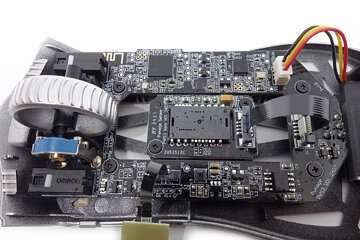 1
1
Pwnage Trinity CF Review
Sensor & Performance »Build Quality
Overall build quality is mostly solid. When shaking the mouse, a rattle comes from the main buttons. When applying lateral pressure, no creaking or flexing of the shell can be observed. Of note, however, is that the bottom flexes to a noticeable degree. Activating the side buttons by squeezing the sides is impossible. Lastly, accidental clicks when slamming down the mouse do not occur.Buttons
Main buttons on the Trinity CF are good. Pre-travel is low and post-travel moderate, resulting in a firm and snappy button response. The buttons aren't entirely uniform, as the right one feels slightly crunchy and less defined than the left button. That said, this sensation largely subsided after disassembly and re-assembly of the mouse. Compared to other mice using the same switches, these seem higher-pitched. Despite being visually separated from the shell, button movement is low even when provoked. Button stiffness is medium to light. A pair of Omron D2FP-FN2 (China) optical switches are used here.
Side buttons are very good (back button) to excellent (forward button). Though pre-travel is a bit higher on the back button, both pre and post-travel are low on either button, resulting in pleasing actuation. The actuation point is even across the entirety of these. Button placement is good as actuation is possible quite easily by rolling one's thumb across. A set of surface-mounted switches from Omron (blue plunger) are used for these.
A simple on/off-slider is found on the bottom, which works fine.
Scroll Wheel
The scroll wheel is good. Noise levels when scrolling up are rather high, but tactility is above average, with fairly well-defined steps. The encoder comes from TTC (blue, yellow core) and has a height of 9 mm. The middle (scroll wheel) click requires high force for actuation. A seemingly unbranded tactile switch is used for this one.
Surface
The Trinity CF has a matte surface all over. Grip is fine, and it doesn't attract fingerprints or dirt too much. It is easy to clean, and there are no signs of wear left after doing so. All in all, excellent materials.Button Sound Test
Disassembly
Disassembling the Trinity CF is very easy. The screws are found beneath the rear skates. After removing those, two additional clips at the front need to be dislodged, which is easily done. When separating top and bottom shell, make sure not the rip the cable connecting the two.
The internal design is efficient. The side buttons sit on their own PCB screwed to the top shell and connected through a ribbon cable to the main PCB. The sensor likewise sits on its own PCB connected to the main PCB through a ribbon cable. Two screws are used to affix the sensor PCB to the plastic assembly used to adjust sensor position. The plastic assembly is attached to two rails positioned laterally, and by loosening and tightening the screw associated with each rail the sensor PCB can be moved around. Everything else sits on the thin main PCB, which is affixed to the bottom with four screws. The MCU is a Nordic nRF52840, whose datasheet is found here. The Bluetooth capability of the chip remains unused. Due to the coating present on it, identifying the secondary USB High-Speed MCU isn't possible. Production date for all PCBs is the 37th week of 2024.
As for the soldering and general quality of the PCB, I'm unable to find any noteworthy flaws.
Apr 18th, 2025 05:00 EDT
change timezone
Latest GPU Drivers
New Forum Posts
- Help For XFX RX 590 GME Chinese - Vbios (9)
- Issues with drivers 566.36 and NVCleanstall v1.17 (45)
- NVIDIA GeForce 576.02 WHQL driver (1)
- It's happening again, melting 12v high pwr connectors (1025)
- Will you buy a RTX 5090? (480)
- Subsystem Id of my Asus Strix RTX 4090 OC / Random GPU detection problem (7)
- RX 9000 series GPU Owners Club (373)
- D5400XS Skulltrail (1)
- Random Entire System Stutter when using Throttlestop (7)
- Help needed OC on Intel 285k (3)
Popular Reviews
- ASUS GeForce RTX 5060 Ti TUF OC 16 GB Review
- NVIDIA GeForce RTX 5060 Ti PCI-Express x8 Scaling
- G.SKILL Trident Z5 NEO RGB DDR5-6000 32 GB CL26 Review - AMD EXPO
- Palit GeForce RTX 5060 Ti Infinity 3 16 GB Review
- ASUS GeForce RTX 5060 Ti Prime OC 16 GB Review
- Zotac GeForce RTX 5060 Ti AMP 16 GB Review
- MSI GeForce RTX 5060 Ti Gaming OC 16 GB Review
- MSI GeForce RTX 5060 Ti Gaming Trio OC 16 GB Review
- Teevolution Terra Pro Review
- ASUS GeForce RTX 5080 TUF OC Review
Controversial News Posts
- NVIDIA GeForce RTX 5060 Ti 16 GB SKU Likely Launching at $499, According to Supply Chain Leak (182)
- NVIDIA Sends MSRP Numbers to Partners: GeForce RTX 5060 Ti 8 GB at $379, RTX 5060 Ti 16 GB at $429 (127)
- Nintendo Confirms That Switch 2 Joy-Cons Will Not Utilize Hall Effect Stick Technology (105)
- Over 200,000 Sold Radeon RX 9070 and RX 9070 XT GPUs? AMD Says No Number was Given (100)
- Nintendo Switch 2 Launches June 5 at $449.99 with New Hardware and Games (99)
- NVIDIA Launches GeForce RTX 5060 Series, Beginning with RTX 5060 Ti This Week (97)
- Sony Increases the PS5 Pricing in EMEA and ANZ by Around 25 Percent (85)
- NVIDIA PhysX and Flow Made Fully Open-Source (77)








